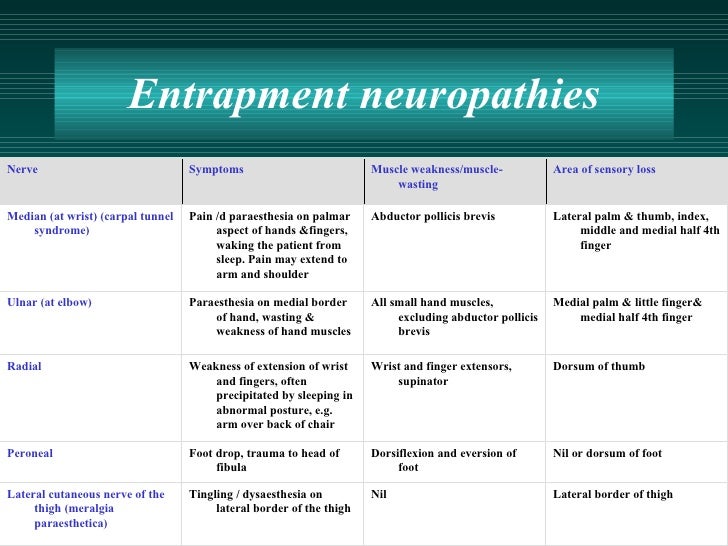ENTRAPMENT NEUROPATHY
Introduction
- nerve in a space of limited compliance vulnerable to compression
- carpal, cubital, ulnar tunnels, deep to fibrous bands and tendinous arches
- increase in volume of a material in this space – increase pressure – compress nerve- mechanical peripheral neuropathy

Pathophysiology
- effects on structure and function
- severity depends on magnitude and duration of compression
- myelin damage – blood flow alterations - ischemic changes
- elevation of pressure in nerve - <40mmHg- sensory nerve function changes – reversible with restoration of blood flow – motor dysfunction at higher pressure and sustained elevation
- chronic compression - intraneural scarring, edema – due to prolonged ischemia
- structural changes – alterations or loss of myelin coatings of nerve fibers – in c/c high pressure compressions esp involving edges – resolve only in some time
- also inhibit axoplasmic flow – both antegrade and retrograde – diminishing the nerve function – contributing to bulging appearance of nerve proximal and distal to site of compression.
Clinical evaluation
- Sensory threshold testing
- how well a single nerve fiber innervating a receptor or group of receptor cell is functioning
- Vibrometry
- Semmeasa Weinstein monofilaments
- pressure to finger tip with filament until filament bends
- pressure required to bend directly related to its diameter
- filaments of successively increasing diameter to determine the sensory threshold of slowly adapting nerve fibers
- Vibration testing
- with 256 Hz tuning fork – to evaluate the sensory threshold of quickly adapting nerve fibers
- Innervation density tests
- two point and moving two- point discrimination
- measure multiple overlapping peripheral receptor fields and the density of innervation ie. How many nerve fibers are present and correctly represented in cortex
- compression neuropathy – nerve fibers are not lost – but not functioning well
- nerve laceration – nerve fiber lost
- useful in evaluating nerve laceration and recovery after repair than for evaluating compression neuropathy
- Provocative testing
- tests compress, stretch, percuss the nerve to elicit numbness and paraesthesia in its sensory distribution
- useful in exertional compression neuropathy
- Evaluation of muscle weakness or atrophy
- muscles innervated by nerve is tested for bulk and strength
Electrodiagnostic studies
- only objective test of nerve
- NCV
- sensory nerve action potential and composite motor action potential are wave form of NCV
- measure latency and conduction velocity of sensory and motor nerve fibers
- EMG
- activity of a single motor unit consisting of nerve cell, its fibers and the muscle group it innervates
- positive sharp waves and fibrillation potentials – indicate recent muscle denervation
- small highly polyphasic MUPs and decreased fibrillations – early re innervation of muscle
- MUPs of great duration and amplitude - c/c denervation with collateral re innervation resulting form adjacent nerve sprouting
Laboratory investigations
- r/o hypothyroidism with myxedema, obesity, cervical radiculopathy, DM, alcoholism, exposure to neurotoxic chemicals
Principles of treatment
- splinting, medications, physiotherapy, corticosteroid injections, correction of metabolic abnormalities
- splinting at night – avoid positions that are harmful to nerve function
- NSAIDS, diuretics
- steroid injections after failure of non operative treatment
- indications of surgery
- failure of non surgical management
- acute rapidly progressive involvement
- severe cases
- symptom recurrence
- procedures
- decompression
- nerve transposition or flap coverage – if nerve bed is scarified
Orthopaedics made simple for DNB MS MRCS Support and Guidance for DNB Orthopaedics, MS Orthopaedics and Orthopaedic Surgeons. DNB Ortho MS Ortho MRCS Exam Guide Diplomate of National Board.Our site has been helping dnb ortho post graduates since a long time.It has been providing the dnb ortho theory question papers,dnb orthopedics solved question bank, davangere orthopaedic notes, sion orthopedic notes.We provide guidance to post graduates as to how to pass dnb and ms ortho exams, and aspiring orthopaedic surgeons surgical technique teaching videos and orthopaedic books and pdf.
Get updates email orthoguidance@gmail.com whatsapp 9087747888
- Study Material to Pass Any Orthopaedics Exam
- Davangere Orthopaedic notes pdf
- Dawangere Ortho Notes Hard copy all volumes 2017 edition
- DNB Solved Question Bank with Answers
- Ortho Theory Exam Package
- Ortho Practical exam package
- Ortho case presentation videos
- Orthopaedic Journals
- Orthopaedic Physical Examination video Atlas
- Sion Hospital Orthopaedic Notes
- Orthopaedics Proformas and scheme of practical examination
- Orthopaedic instruments videos and extras
- Video Atlas of Human Anatomy
- Ortho Practical Exam Guide
- MRCS Package
- Orthopaedic Surgery Technique teaching videos - Trauma
- Orthopaedic Surgery Technique teaching videos - Arthroplasty
- Orthopaedic Surgery Technique teaching videos - Spine
- Orthopaedic Surgery Technique teaching videos - Shoulder Arthroscopy
- Orthopaedic Surgery Technique teaching videos - Knee Arthroscopy
- Anatomical Approach technique and exposure teaching videos
- Orthopaedic PG Course Videos










Keep your glucose level at any rate near ordinary inside and out as could reasonably be expected. There isn't a lot of assurance you can ever take from controlling your glucose aside from the anticipation of tenacious outcomes of diabetes entanglement.
ReplyDeleteNY acupuncture
The vast majority of the passings on the two sides of that war were not the aftereffect of real battle but rather to what exactly occurred after a combat zone wound was delivered.
ReplyDeleteacupuncture commack NY
There are various sorts of neuropathy. Each has it's own pathology. Despite the fact that various sorts of neuropathy make distinctive harm the nerves, they all offer a typical nerve imperfection that is liable for the consuming, deadness and other neuropathy indications. https://thecentrenb.org/
ReplyDelete